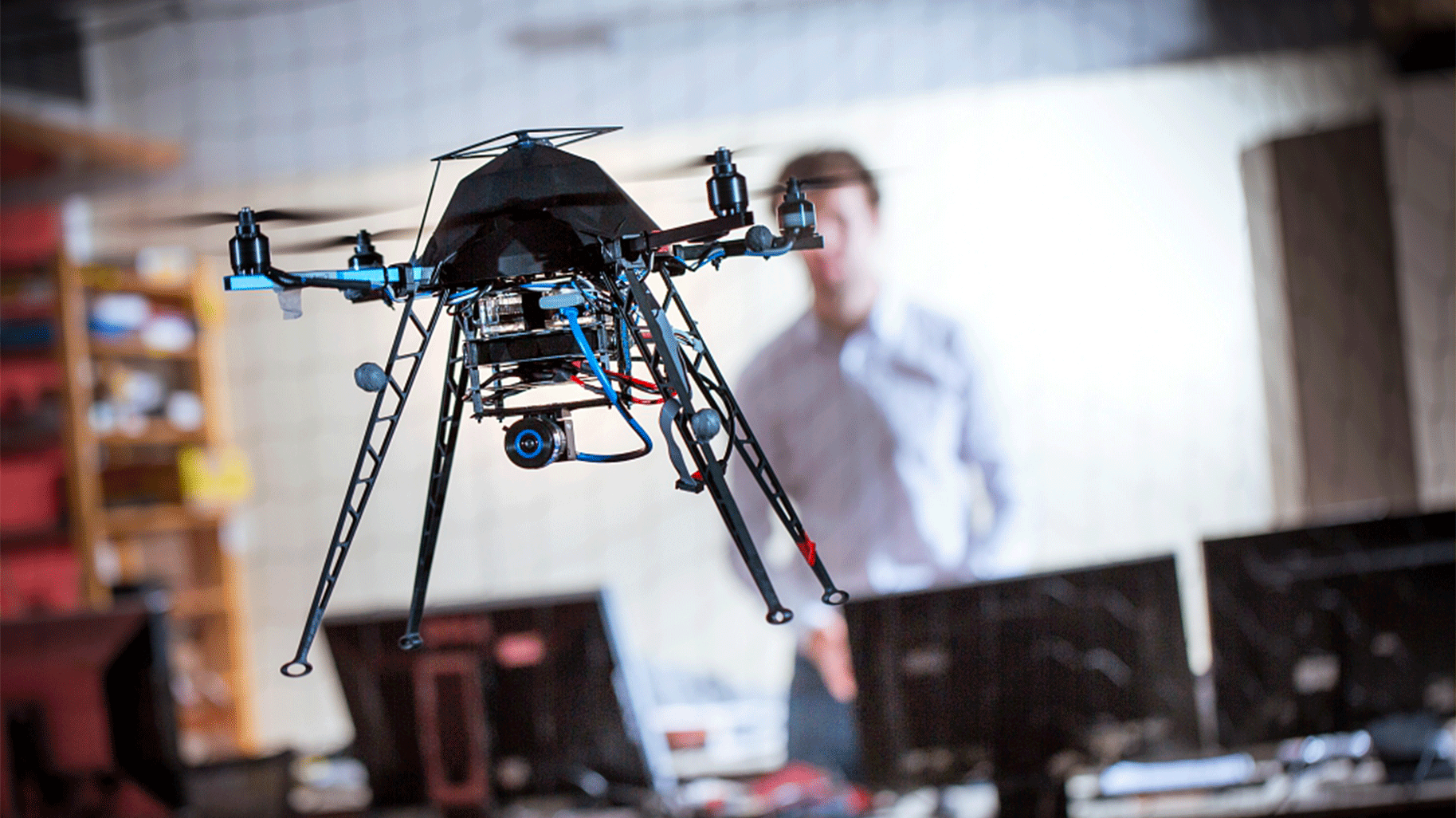
Telekyb3
A tool of note in this research is Telekyb3. This framework for designing aerial robots was started a decade ago at the German Max Planck Institute, by scientists Paolo Robuffo Giordano —now head of Rainbow— and Antonio Franchi who then moved to French LAAS and more recently to Twente University, in the Netherlands. In the process, Telekyb3 came to be adopted by these three latter institutions. “It's an open source software and everybody is welcome to use it.”
“Rolling up their sleeves. Getting their hand dirty. Handling wrenches. Unscrewing bolts. Flipping levers. Moving stuff.
Interacting with their surroundings. That’s what we want our aerial robots to be able to do. In other words: perform real physical work. We are talking about not just better ways to control and plan robot movements, but also a whole new kind of flying robot with fancy actuators and sensors that can tackle real-world tasks all on its own. We believe it could be a game- changer for industries. When it comes to going up on a building, on a bridge, on a power line or on a wind turbine, you will need either cables, scaffolding or helicopters. These systems can be expensive and sometime even dangerous for a human operator. That is where aerial robotics can be very useful and bring a lot of value,” sums up Marco Tognon.
A member of Rainbow[1], a robotics team at the Inria Center of the Rennes University, the scientist was recently awarded funding by the French National Research Agency (ANR) in order to consider a decidedly fresh approach that could lay the methodological foundation required if these flying laborers are to see the light of day. The project is called FlyHandyBot. It will span over the next four years, involving two PhD students and one engineer.
Looking at the Whole Picture
Although robotics is brimming with innovations, there hasn’t been any real blue-collar drone toiling in the sky so far. Why? Because coming up with such a machine is everything but a walk in the park. “There is actually a whole bunch of challenges to tackle. You must figure out how to design robots that are efficient and reliable, how to understand what is going on around them, how to plan out their actions, how to sense what is happening, and how to control their movements without causing chaos. The way people usually deal with these questions is by breaking them into tiny pieces. They focus on things like designing the robot, planning how it moves, controlling its actions or making sure it can sense its environment. And then, they hope that, by magic, all those components will work together. In reality, they do not. That is why some projects have failed. People have tried to subdivide a problem into sub-problems, assuming that they are completely independent one from another. But they are not.
Folks often forget that all these parts are connected and need to work together smoothly.”
Hence the decision to embrace a holistic method.

Verbatim
Instead of chopping the problem into bits, we are looking at the whole picture. We are not treating design, sensing, control, and motion planning as separate things. We see them as one big, interconnected system. We are combining everything all in one go. Think of it like a well-oiled machine, where everything works together seamlessly.
Researcher scientist (ISFP) - Rainbow Team
In the first part of the project, the methodological aspects are to take center stage. “We intend to define new theoretical methods in terms of control and motion planning. We want to find the set of algorithms that, given certain input from the sensors that we use and the objective that we have, will compute what are the motions and the actuation commands needed in order to perform the desired objective.”
More Muscle Needed
A key challenge deals with enhancing the actuation properties of the system. “In a way, we need more efficient muscle.
According to the best state of the art, what scientists managed to do so far, is to prove that an aerial robot can exert a force on the environment, and especially on static walls. Imagine a sort of finger that can touch the wall. This is where we stand right now. And it is already very valuable because the drone can perform non-destructive tasks. For instance, when it comes to assessing the healthiness of a high structure, there are cases in which it can’t be done by simple visual inspection and one really needs to get in contact with the structure. But the robot does not manipulate the environment per se. Since they have to be light weight, the motors do not provide the actuation properties that you would need to control precisely the force that the robot is exerting. You can control the position of the robot, but not its force.” Mitigating this problem will call for cutting-edge pieces of hardware including tiltable propellers and articulated arms.
Another thorny issue regards the fact that the robot must reason about the sensed information. “There might be wind up there. Therefore, the posture can be different at any time. The robot has to pick this information in real time, understand what needs to be its next action in terms of motion and also execute the task. In the next iteration, a new wind situation will occur, so the robot will have to engage into replanning and acting all over again.” And this, in the blink of an eye.
Solving Multiple Tasks Simultaneously
Compounding the problem is the fact that those buzzing machines do not boast the complex kinematic structure that humans enjoy. “It is just a camera attached to the robot. It should be able somehow to constantly look at what is going on for the robot to keep working.” Here things get really tricky. “You try to solve not one but multiple tasks simultaneously: you must see, plan and act all at once. Not to mention the fact that your platform has three degrees of freedom in space, three degrees of rotation, propellers spinning at a high frequency, articulated arms and that it is exerting forces, pushing the environment. All together, it is a very complex dynamic that requires fast resolution.”
Noticeably enough, the main source of inspiration for this project comes from “communities such as legged robots, humanoids and manipulators. Because what we want to do is what they did 10 years ago. But we can’t just take what they have done and applied it for aerial robotics. Our system is completely different. A ground robot can perform manipulation tasks, but it is grounded, so you can push it as much as you want and it won’t move. It relies on contact to the ground. A flying system is unstable, it produces forces thanks to some aerodynamic effects, which are very complicated to model, very unstable, very unpredictable. The wind for instance is something that you don't see. So even if the methods are inspired by these other communities, a lot of works has to be done to address the specific challenges of aerial robotics.”
The formulation of new methodologies will be illustrated by a string of prototypes. “We have some cool experiments in mind. Imagine a robot opening a valve without any human help, using only its onboard sensors. Or how about a robot pushing a box to a specific spot, again, all on its own? We will even throw in some twists, like making the robot dodge obstacles in a cluttered area while performing these tasks.”
A Game-Changer for Industries
The feasibility of these concepts will be first tested in Rainbow’s in-house lab. “But if everything goes well, Tognon says, we will take this show on the road and try it out in a real place, like a water plant for instance. We want to demonstrate that these ideas can actually work and be useful in everyday life. We are pretty sure that this research could make a big impact. We believe aerial robots capable of handling complex tasks could be a game-changer for industries. When it comes to going up on a building, on a bridge, on a power line or on a wind turbine, you will need either cables, scaffolding or helicopters. These systems can be expensive and sometime even dangerous for a human operator. That is where aerial robotics can be very useful and bring a lot of value.”
At the end of day, FlyHandyBot could lead to some technological transfer. “We might even start our own little startup accelerator to make it all happen..."
[1] Rainbow is a project team of Inria, CNRS, Rennes University and Insa Rennes, common to Irisa.

Know more about Flyhandybot project with Marco Tognon (in english)
-